"A South View of the New Fortress at Crown Point, with the Camp ... 1759" by Thomas Davies,
(American Paintings and Related Pictures in the The Henry Francis du Pont Winterthur Museum
by Edgar P. Richardson, 1986)
"A South View of the New Fortress at Crown Point, with the Camp ...
1759" by Thomas Davies,
(American Paintings and Related Pictures
in the The Henry Francis du Pont Winterthur Museum
by Edgar P. Richardson, 1986)
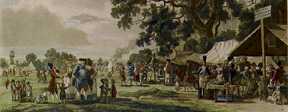
In June 1780, a mob of 50,000 with Lord George Gordon at its head marched on
Parliament calling for the repeal of a recent act granting relief to Roman Catholics.
During the next few days London was the scene of the worst riots in its history.
Martial law was proclaimed and the army moved into Hyde Park, and other regiments
camped outside London at Blackheath. Paul Sandby made several paintings (13"
x 17") of the encampments which show many aspects of camp life. Here
are a few of those works which I have found in books, auction catalogs, and
from photos from the Victoria & Albert Museum, National Army Museum, and
Scottish United Services Museum, were provided by Linnea Bass. If there is some
detail in any of these images that you want to see close up please let us know
and we shall attempt to provide it to you via email.
You are looking down Sutlers row. Notice the soldiers mingling with civilians in the canteens. In the right foreground a women has a table in front of a sutlers stall. She is holding a scale and selling the dragoon gingerbread cookies or cakes. On the table is a bowl of pears or limes.
The sutlers have "X" leg tables and simple plank benches.

Another Paul Sandby work, which appears to be looking from behind Sutlers row
towards the front. Note the sign at the head of the street, is this the back
of the sign on the first image? The bench on the left has splayed legs. The
tables on the right appear to have legs made of crooked tree limbs. From an
unidentified art book, the work is titled "The Military Encampment in Hyde
Park, 1780"

This Sandby scene clearly shows camp furniture in the marquees. In the left
marquee are several slat back chairs in front of a camp cot. On the right side
an officer holds the standing pole of a large wedge or wall tent, and appears
to be talking to another officer whom is slouching in his chair, while resting
his arm on a table. The tower in the background appears to be Westminister Abbey.
From Chrisitie's Fine English Drawings and Watercolors auction catalog,
13 July 1965. Also pictured in The Art of Paul Sandby by Yale Center
for British Art, Yale University, CT 1985.
Two views of 1780 encampments near the Serpentine River from Sandby Drawings
at Windsor Castle
by A.P. Oppe, London, 1947.
On the top image, note on the extreme left side the man with the wheelbarrow.
Look closely and see his dog is wearing a harness and is pulling the wheelbarrow.
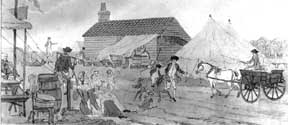
This plate from the National Army Museum is titled "A Camp Kitchen in Hyde
Park". Under the awning affixed to the building in the background a woman
is washing trenchers. The baskets to her right may have been used to store the
cleaned trenchers. At the extreme left a man wearing an apron appears to be
tending a fire upon which is a tall vessel, while speaking to a man seated at
the building corner. In the left foreground, in front of the sutlers tent, an
older man leans back in his chair observing the action in the street. Another
man in a jacket crosses the street carrying two pails of water, probably for
the washerwoman. Seated in the foreground two women, with an infant standing
on one womens lap, observe the pony ride. A young boy rides a pony while guided
by a man in a frock coat. Running alongside the pony is a toddler with a cane
between the legs and a stick in hand, mimicking the boy on the pony. Entering
the scene on the right is a man aboard two-wheel cart of which the contents
cannot be discerned. In the distance behind the cart rider a column of soldiers
led by drummers marches in camp.
Another plate from the N.A.M., titled "A Prostitute Drummed Out of Camp
in Hyde Park, 1780". The prostitute, with her hands over her ears, is marched
out by seven drummers. The tallest drummer whom may be the drum major, has an
ostrich plume across the rear leaf of his hat. One of the officers escorting
her extends his arm, as if to restrain a woman holding a large stick whom appears
to be taunting the prostitute. One of the children with the woman also carries
a stick. From the right, perhaps from the marquee, another woman with a child
and dog rushes towards the scene. At the extreme right a woman sits at a table
with a knife in hand. She is surrounded by baskets of food: potatoes?
On the extreme left an older officer with two ladies and a child observe the
scene with the lady at the left gesturing "good riddance" to the prostitute.
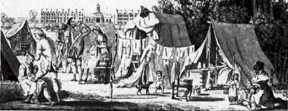
There is so much to see in this image of a camp street. Soldiers are braiding
hair on the left. On the right a mother grooms her children. A dog is begging
in the door of a wedge tent. In the center foreground a washtub sits on a slat
back chair. The the left a dog seems to be nipping at a child. Laundry hangs
from rope strung between the tents and a pole in the street. In the left background
a soldier brushed his hair as a women works to his right. From Christie's Fine
English Drawings and Watercolors auction catalog, 22 February 1966.

"Extensive Dining Fly" from Encampment at Hyde Park by Paul Sandby,
1780. This vacant mess tent has several tables and benches clearly visible.
The tentage seems to be a torn marquee roof. From Paul and Thomas Sandby
by Luke Herrmann (London, 1986).
These unattributed images, from the Scottish United Services Museum, titled
"Scenes of the Camp on Hampton Green 1731". The first depicts two men
erecting a bell back wedge tent. A set of upright and ridge poles stand in the
background, as if to show the inner structure of the tent. The second image
is a cut-away showing four men in the tent laying in a bed of straw. Their hats
are visible in the bell area of the tent.
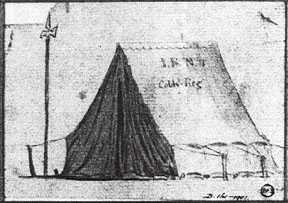
Serjeants wall tent of the Coldstream Guards in the Netherlands, circa 1748
by Thomas Sandby. Drawing courtesy of George Woodbridge, description from Sandby
Drawings at Windsor Castle by A.P. Oppe, London, 1947, pg 47, item 156.
The scallops along the ridge are painted alternating colors: 2 red, 2 blue,
2 red, etc... Not shown are the privates tent behind this serjeants wall tent,
they are numbered 1 B No. 2, 1 B No.3, etc...

Two perspectives of the encampment and inspection of the 2nd West Yorkshire
Light Infantry Militia, at Old Montague House by S.H. Grimm, c.1780. The tents
are flat backed and appear to be approx 7 feet tall. Note the nearly identical
decorations on the marquee roofs. From Military Drawings and Paintings in
the Royal Collection by A.E. Haswell Miller & N.P. Dawnay (London, 1966)
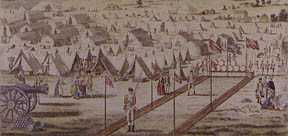
"A Perspective View of an Encampment" by Bowles & Carver, 1780.
From the A.S.K. Brown Military Collection, Brown University.

"Encampment of the Loyalists at Johnstown, on the Banks of the River St.
Lawrence in Canada" by James Peachey, 6 June 1784. The wedge tents are of
varying heights and most have red trim along the ridge. From the Public Archives
of Canada.
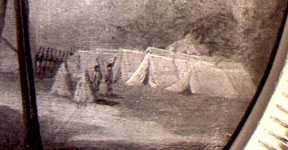
This is detail from a portrait of an unknown officer of the 32nd Foot. Note
how tall the wedge tents are in relation to the height of the soldiers. The
two bell of arms are clearly visible. This painting was in the A.S.K. Brown
Military Collection (Providence, RI) until auctioned by Sotheby's in
1986, current whereabouts unknown.

From the Peale portrait of Col. Walter Stewart, Pennsylvania Line, c.1781. I
believe this portrait now belongs to Yale University. Note the soldiers standing
and sitting on the edge of the cooking trench. The cook fires are dug into the
mounded earth, which is the manner recommended by British military texts of
Francis Grose History of the British Army (1686) and Smith's
Universal Military Dictionary (1779).
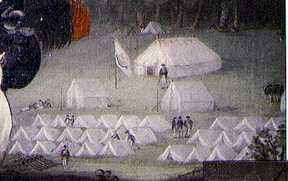
Zooming in to the right of Col. Stewart clearly shows ridge decoration on the
marquee, sentries, two wall tents, and many relatively low wedge tents. On the
left foreground note the muskets resting on a cross bar. To the left and behind
the marquee is a single wedge tent with a sentry: quarter guard post? No seats,
chairs, benches, or trunks are visible.

Detail from a watercolor of the Constitution Island/West Point area Continental
Army encampments by Pierre Charles L'Enfant, c.1782. Several Conestoga type
wagons and irregular shelter tents are visible.
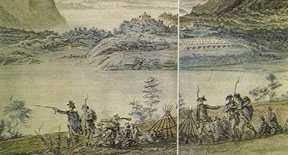
In the distance are several rows of tents on Constitution Island. In the foreground
an officer and NCO direct several soldiers wearing knapsacks . Other soldiers
are resting while their arms, with fixed bayonets, are stacked. The soldier
second from the left appears to have a white service chevron on his coat sleeve.
From The World of George Washington by Richard Ketchum.
Prohibited Camp Seats
The two seats pictured below have been prohibited in the B.A.R.
and British Brigade because they are not authentic for the Revolutionary War period.
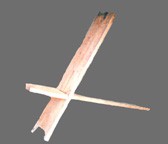
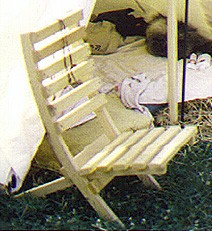
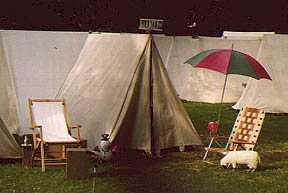
On the left is a seat made of two interlocking planks. In the center is the
ubiquitous rendevous camp seat. This seat is usually made of slats attached
to a folding frame. They do have one approved use in camp: firewood. On a lighter
note - can you find the anachronisms in the camp scene on the right? Thanks
to Jack Frost of Delancey's for this beauty (it's his tent) and he took
the stuff down before camp opened.
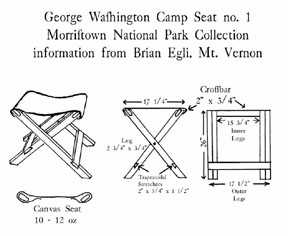
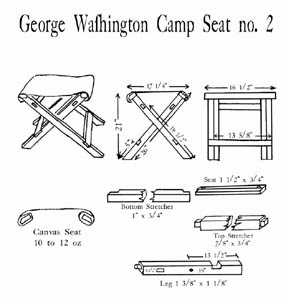
Above are two measured drawings for the folding camp seat used by General Washington.
At least one of these seats is at Mount Vernon. The frame is made of Black Walnut.
The seat is of leather but is believed to be a replacement. The major difference
between the two seats is the method of joinery. Similiar seats are reputedly
illustrated in a German military text of the 1780's.
To print either drawing set your printer to landscape mode.
Seat No.1 has a bottom stretcher dovetailed into the legs. The seat stretcher is of groove & spline construction.
Seat
No. 2 has a bottom stretcher set into the leg dados. The upper stretcher is
mortise & tenon construction. The seat stretcher is pinned to the legs.
Uploaded 1-30-1999
Updated 4-16-2013